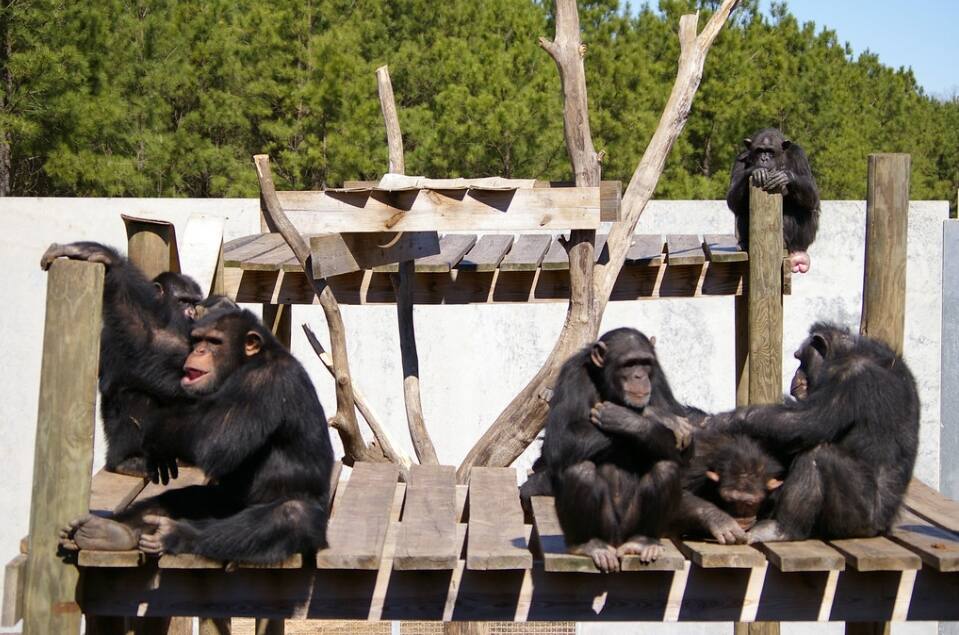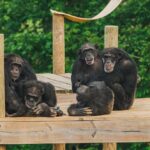The final cohort of Pan troglodytes from the Alamogordo Primate Facility in New Mexico has completed their translocation to Chimp Haven, the federal chimpanzee sanctuary in Louisiana. This ex-situ conservation effort closes a chapter in biomedical research history and establishes a new paradigm for the ethical treatment of great apes formerly used in scientific studies.
Encompassing 200 acres of enriched habitat in Keithville, Louisiana, Chimp Haven currently houses a population of over 300 retired research chimpanzees in naturalistic social groupings. The sanctuary’s habitat design incorporates primary forest elements essential for proper locomotor behavior, while daily husbandry protocols prioritize species-typical behaviors and social dynamics critical for psychological well-being.
“A lot of the chimpanzees that are here, they spent decades in biomedical research before coming to sanctuary, but Chimp Haven provides their happy endings,” said Rana Smith, the president and CEO of Chimp Haven.
From Research Models to Ex-situ Conservation
As our closest living phylogenetic relatives, chimpanzees became keystone species in American scientific research due to their homologous physiological systems. During the 1950s and 1960s, these hominids were integral to NASA’s space program, serving as biological proxies for testing life support systems and gravitational stress. By the 1970s, their utilization pivoted toward zoonotic and infectious disease research due to their immunological similarities to Homo sapiens.
“Chimpanzees have been used in research for decades,” Smith explained. “So, back in the 1950s and 1960s, they were part of the NASA space program, and in the ’70s, kind of moved into infectious disease.”
Their genetic homology to humans—sharing 98.7% DNA sequence identity—made these great apes critical for developing the Hepatitis B vaccine and advancing HIV/AIDS research protocols in the 1980s. This same genetic proximity eventually sparked ethical reconsideration of their captive use under the evolving framework of great ape personhood and welfare ethics.
Public sentiment and scientific consensus evolved in the late 1990s, culminating in the Chimpanzee Health Improvement, Maintenance, and Protection (CHIMP) Act of 2000. This legislative framework established the federal sanctuary system for retired research chimpanzees, mandating 75% financial support from the National Institutes of Health (NIH) for lifelong care and welfare.
By 2015, following recommendations from ethologists and primatologists, NIH announced termination of all invasive biomedical research on chimpanzees, classifying all federally-owned or supported individuals as retirement-eligible. However, the translocation process from laboratory environments to sanctuary settings encountered significant logistical and welfare challenges.
The Final Alamogordo Translocation
The recent translocation of 23 geriatric chimpanzees from the Alamogordo Primate Facility at Holloman Air Force Base marks the culmination of a protracted welfare intervention. These individuals remained in the non-sanctuary setting long after their conspecifics were transferred, with officials citing age-related morbidities and transport-associated stress risks as contraindications.
Following a 2022 legal intervention by the Humane Society of the United States and allied conservation organizations, a federal judiciary mandated the chimpanzees’ transfer to sanctuary conditions. Initially, NIH veterinary personnel maintained that the subjects’ physiological status contraindicated transport despite sanctuary veterinarians’ differing assessments of transport viability.
The impasse resolved in late 2023 when NIH reversed its position, citing imminent retirement of specialized caregiving staff at the Alamogordo facility as the determinative factor necessitating relocation.
“It was a big surprise to receive word from NIH that they decided to transfer the remaining chimps,” Smith says.
The translocation occurred in four discrete cohorts using specialized transport protocols. Regrettably, one female named Patricia experienced mortality during transport, with preliminary assessment indicating anesthetic complications as the likely etiology. Following this adverse event, subsequent transports proceeded using minimal sedation protocols.
“The rest of the chimpanzees were actually moved into their transport crates without anesthesia, and it was smooth sailing,” Smith says. “We didn’t have any additional issues. And all of those chimps are really doing well, settling in at Chimp Haven and just starting to thrive.”
Novel Fission-Fusion Dynamics
Among the recently translocated individuals, Al and Kamaka—two wild-born males in their fifth decade—are experiencing social complexities and female conspecific interactions previously absent in their captive history.
“Right off the bat, they were just enamored with the ladies in the group,” says Smith. These two males underwent careful integration into an established multi-male, multi-female social unit that includes a resident male named Tabu and four adult females. Smith notes that Tabu “doesn’t mind sharing his lady friends”—displaying the flexible dominance hierarchies typical of wild chimpanzee communities rather than the territorial aggression often seen in limited captive environments.
Similar Posts
Based on lifetime records, sanctuary primatologists believe that in captivity, Al and Kamaka “never experienced living with females before,” representing a significant enrichment milestone in their behavioral repertoire.
Of the 21 Alamogordo chimpanzees, five individuals have completed integration into established social groups following standard quarantine and introduction protocols. The remaining 16 currently inhabit specialized quarantine habitats pending completion of additional multi-acre outdoor enclosures designed for natural locomotion and foraging behaviors.
The “Chimp Life” Ecosystem
Chimp Haven maintains approximately 30 distinct social groups, each exhibiting unique dominance hierarchies, affiliative networks, and intragroup dynamics. The sanctuary’s welfare-centered management prioritizes enabling species-typical behavioral repertoires including brachiation, allogrooming, tool use, nest-building, and the natural reconciliation behaviors critical to chimpanzee social cohesion.
The husbandry economics reflect the specialized needs of great ape care: each chimpanzee requires approximately $25,000 annually for comprehensive welfare maintenance. Nutritional requirements alone are substantial—the sanctuary’s commissary processes 117,000 bananas annually as part of their varied diet designed to promote naturalistic foraging behaviors.
Colony Director Michelle Reininger employs individual identification and behavioral profiling for each chimpanzee, recognizing their distinct cognitive and temperamental traits.
“I like the sassy ones,” she said. “I like the ones who you have to really work hard to get them to respond to you, and to trust you. When you get that trust, there’s no feeling like it in the world, to have that bond with an animal.”
Daily husbandry protocols include environmental enrichment implementation, facilitation of fission-fusion social dynamics, and regular veterinary interventions under the direction of professionals like Dr. Raven Jackson.
“Chimpanzee medicine is challenging,” Jackson said. “It’s like working with a really strong toddler. And so, I always say, each day I start with, ‘Am I smarter than a chimp?'”
Jackson’s veterinary practice encompasses diverse pathologies across a demographically varied population ranging from juveniles at age 7 to geriatric individuals in their mid-60s. Many exhibit age-related comorbidities analogous to those in geriatric human patients, requiring specialized geriatric great ape medicine protocols.
“Younger chimps here as well yes so as young as seven all the way up into the you know mid 60s,” Jackson said. “It keeps things very interesting. And I think it also keeps things interesting for the chimpanzees, because we’re able to put them in these very dynamic social groupings where you’re going to see various age ranges.”
The chimpanzees’ conflict resolution behaviors provide observational learning opportunities for their human caregivers.
“They always want to reconcile very quickly,” said Jackson. “It taught me, hey, it isn’t worth holding onto anything. Like, learn from the chimps. Let it go. Reconcile, so that you can continue to move forward as a group.”
Conservation Challenges and Ethical Obligations
The sanctuary currently approaches carrying capacity, with infrastructure expansion projects underway to accommodate the recent translocations. The Phase IV habitat expansion requires capital investment exceeding $4 million, sourced primarily through philanthropic contributions from foundations including the Annenberg Foundation.
A remnant NIH chimpanzee population persists at two specialized facilities in Texas. According to Smith’s assessment, these individuals remain primarily due to strong pair-bonding with conspecifics exhibiting contraindications for transport. Conservation ethics dictate that upon mortality of their frail social partners, the remaining individuals should qualify for sanctuary translocation if their physical condition permits.
The ethical imperative for sanctuaries like Chimp Haven may eventually diminish in scope. A decade ago, NIH declared cessation of support for invasive chimpanzee research protocols. This paradigm shift forecasts an eventual conclusion to the involuntary conscription of chimpanzees into biomedical studies.

When questioned regarding ethical obligations toward these great apes, Smith articulated: “Chimpanzees have given so much of their life to science. And we feel like it’s our responsibility, and the government’s responsibility to care for those chimps for the rest of their life.”
For Al, Kamaka, and the other sanctuary residents, Chimp Haven provides crucial access to vertical space for brachiation, complex social matrices for cognitive stimulation, and opportunities for affiliative behaviors previously inaccessible during their research tenure. After decades contributing to human medical advancement, they can now express their full behavioral repertoire as the complex, sentient great apes they are.

















